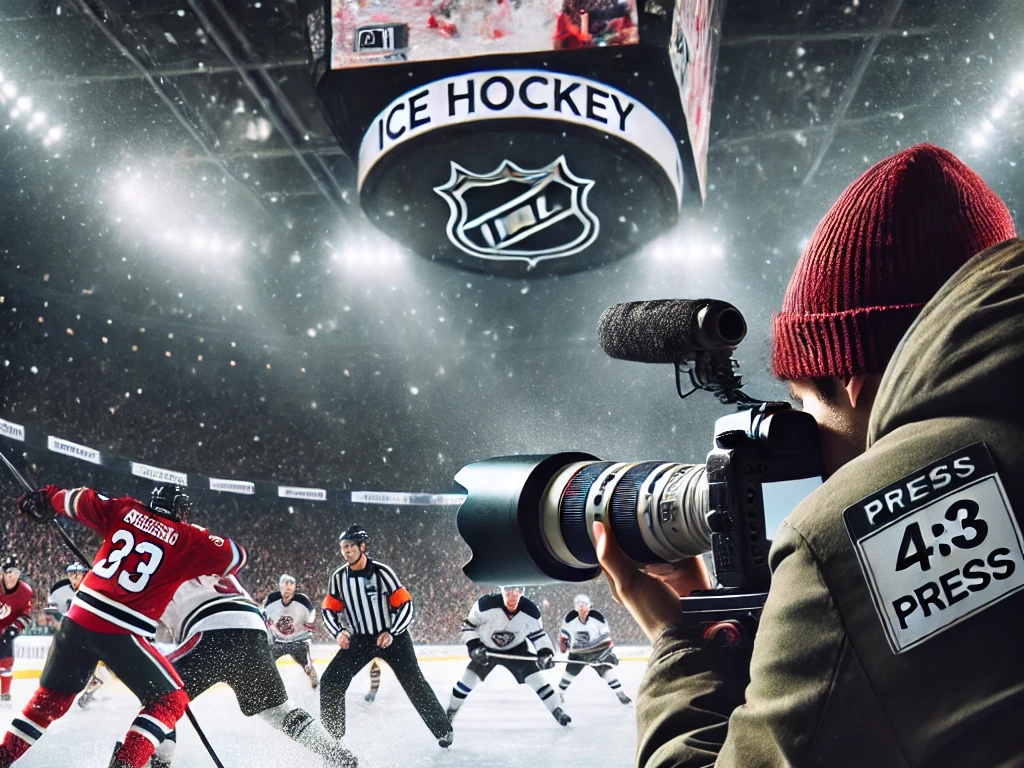In the ever-evolving field of sports journalism, there are few beats as exciting and challenging as ice hockey coverage. Ice hockey is a game that combines speed, skill, and raw physicality, giving journalists a variety of angles to explore, from strategic game breakdowns to intimate stories of human interest. The United States Press Agency (USPA) is enhancing the ability of sports journalists to cover hockey by providing tools, resources, and access that turn standard coverage into compelling storytelling.
This article delves into the intricacies of sports reporting with a focus on ice hockey and shows how USPA membership can enrich a journalist’s coverage and improve their craft.
1. The special challenges of ice hockey coverage
Ice hockey presents sports journalists with a unique set of challenges that require quick reflexes, deep knowledge and the ability to translate fast-paced action into compelling narratives. The speed of the game, the fluid movements on the ice and the high stakes on each play require journalists to remain vigilant in order to capture decisive moments.
For a journalist covering ice hockey, it’s important to understand the technical aspects of the sport – such as power plays, penalty kills, and line changes. USPA membership equips reporters with access to game footage, statistical databases, and expert analysts so they can break down these complex elements for their audience.
In addition, when reporting on ice hockey, you often have to find your way around cold environments, nighttime games, and high-intensity atmospheres. The ability to adapt and perform in such conditions is a hallmark of successful sports journalism, and the training resources offered by the USPA help journalists improve these important skills.
2. Preparing for Reporting: The Foundation for Excellence
Preparation is the cornerstone of every successful sports story. Hockey coverage begins long before the puck drops, with detailed research on teams, players, and recent trends in the league.
Research of teams and players
Journalists who report on ice hockey have to dive deep into the team’s history, player statistics and current rankings. Understanding the context of a matchup – such as a rivalry or impact on the playoffs – adds more depth to the story. USPA members have access to comprehensive resources, including detailed player biographies and historical game records, making this research process seamless.
Understanding audience expectations
Successful reporting also depends on understanding the audience’s perspective. Ice hockey fans are often very knowledgeable and expect coverage that goes beyond superficial observations. By adapting stories to nuanced insights, journalists can meet and exceed these expectations.

3. The thrill of live match coverage
There’s nothing quite like the energy of a live hockey game. The roaring crowd, the sound of skates cutting through the ice, and the unpredictability of what is happening create a charged atmosphere that journalists need to capture in their reports.
USPA accreditation ensures that journalists have first-class access to press boxes, locker rooms and media areas, and can watch the game from the best angles. From documenting game-changing goals to capturing the raw emotions of players and coaches, live coverage requires a keen eye and quick thinking.
Putting actions into words
The fast pace of ice hockey can make it difficult to keep up with the action. However, with practice and the right tools, journalists can master the art of translating dynamic gameplay into vivid descriptions. For example, when describing an objective, the player’s movements, the teamwork that prepared the opportunity, and the reaction of the fans and the team can be described in detail.
4. Building relationships within sport
The relationships that journalists build with players, coaches and other stakeholders are invaluable for sports reporting. Earning the trust of these people opens the doors to exclusive interviews, behind-the-scenes access, and personal stories that resonate with readers.
The USPA facilitates these connections through networking events, media days, and its extensive membership directory. Whether it’s a one-on-one interview with a star player or a casual conversation with a coach, these relationships are the backbone of impactful journalism.
Humanizing the game
Statistics and results aside, it’s the human stories in hockey that really captivate audiences. From a player overcoming adversity to a team’s impact on the community, these narratives bring depth to sports coverage. The USPA encourages its members to explore these angles and offers training on how to ask the right questions and build a relationship with interviewees.
5. Ethical considerations in sports reporting
Sports journalists often face ethical dilemmas, especially when reporting on sensitive topics such as injuries, controversies, or incidents off the ice. Finding a balance between delivering newsworthy content and respecting the privacy and dignity of those involved is a challenge that every journalist must face.
The USPA emphasizes the importance of ethical journalism through its training programs and professional standards. For example, members are advised to rely on verified information, avoid sensationalism, and approach sensitive topics with care and respect.

6. Use of multimedia to improve coverage
Modern sports journalism is not limited to the written word. Multimedia elements such as video highlights, photo essays, and interactive graphics are indispensable tools for engaging today’s audience.
Capturing the action
High-quality graphics are especially important in ice hockey, where the speed of the game can make it difficult for spectators to follow every detail. USPA members have access to sports photography and video editing workshops that allow them to produce compelling multimedia content.
Enrich stories with data
Advanced analytics have become an important part of sports coverage, providing insights into player performance, team strategies, and match results. By incorporating these data points into their coverage, journalists can provide readers with a deeper understanding of the game.
7. Crafting Feature Stories: Beyond the Ice
Feature stories allow journalists to explore broader topics from the world of ice hockey. These include profiles of legendary players, explorations of the sport’s cultural influence, or deep insights into topics such as diversity and inclusion in the league.

Spotlighting Untold Stories
One of the most rewarding aspects of sports journalism is shedding light on stories that would otherwise go unnoticed. For example, a USPA journalist might present a youth hockey program in an underserved community and highlight how the sport is life-changing.
8. The Role of Analysis and Commentary
In addition to covering matches, sports journalists are often used for analysis and commentary. This includes breaking down strategies, evaluating players’ performances, and providing informed opinions on developments in the league.
USPA’s resources, including access to expert analysts and advanced data tools, allow journalists to craft insightful commentary that resonates with readers.
9. Developing a personal brand in sports journalism
In a competitive field like sports journalism, building a personal brand is essential. This includes developing a unique voice, creating a strong portfolio, and interacting with audiences through social media and other platforms.
USPA membership offers numerous opportunities for personal branding, from publishing articles on the platform to participating in industry events. By leveraging these opportunities, journalists can establish themselves as trusted voices in the world of sports reporting.

10. The Future of Ice Hockey Journalism with USPA
As the media landscape evolves, so does the role of the sports journalist. New technologies, changing audience expectations and the growing demand for multimedia content are shaping the future of the subject.
The USPA remains at the forefront of these changes, providing its members with the tools and training they need to adapt and succeed. Whether it’s learning how to use new reporting tools or exploring innovative storytelling formats, the USPA ensures that its members are always one step ahead.
Conclusion: The Power of USPA Membership in Ice Hockey Coverage
Ice hockey is a sport of passion, intensity and drama, and reporting on it requires the same qualities. Through its resources, connections, and educational programs, the USPA empowers journalists to cover this dynamic sport.
For those looking to improve their sports coverage, especially in the exciting world of ice hockey, USPA membership is not just an advantage, but a game-changer. From access to exclusive events to building relationships within the sports community, the possibilities are endless. With USPA, the journey from the rink to the reader becomes a seamless and rewarding experience.
